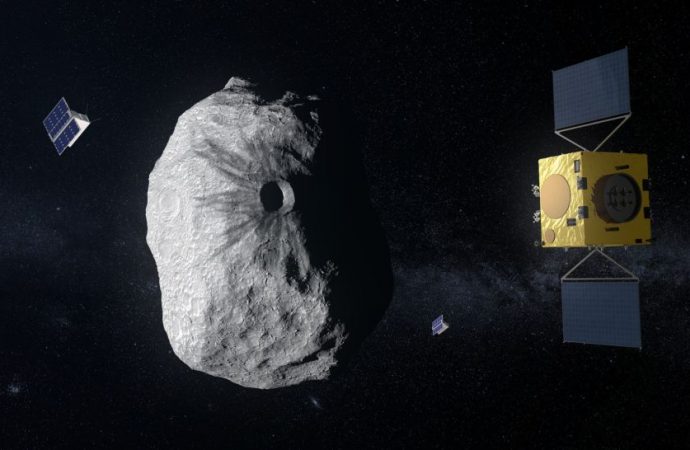The Hera spacecraft will observe the effects of a NASA probe’s high-speed crash into an asteroid.
Source: Space.com
Europe has confirmed its participation in humanity’s first full-on planetary-defense demo.
The European Space Agency (ESA) has officially approved the Hera mission, which will assess the results of NASA’s asteroid-walloping Double Asteroid Redirection Test (DART).
DART is scheduled to launch atop a SpaceX Falcon 9 rocket in July 2021 and reach the Didymos two-asteroid system in October 2022. The NASA probe will then slam into “Didymoon,” the 540-foot-wide (165 meters) satellite of the 2,540-foot-wide (775 m) space rock Didymos.
Telescopes here on Earth will document how the impact affects Didymoon and its orbit around Didymos, helping researchers gauge the effectiveness of the “kinetic impactor” asteroid-deflection strategy. The DART team had long hoped that such long-range data would be supplemented by up-close observations, and now that vision will become reality.
Hera will likely launch in 2023 or 2024 and get to the Didymos system two years later. The European spacecraft will gather a variety of types of data about the space rocks with the aid of two tiny cubesats, both of which will perform asteroid landings, ESA officials have said.
The Asteroid Prospection Explorer (APEX), which was provided by a Swedish-Finnish-Czech-German consortium, will investigate the interior structure and surface composition of both asteroids in the system. And Juventas, which was built by the Danish company GomSpace and the Romanian company GMV, will study Didymoon’s structure and gravity field.
DART will also feature a cubesat. The Italian Space Agency’s briefcase-sized Light Italian Cubesat for Imaging of Asteroids (LICIA) will separate from DART shortly before the big probe hits Didymoon; LICIA will observe the impact from a safe distance, beaming data and photos home to Earth.
Originally, by the way, an ESA craft was supposed to do this real-time impact-observing work. The Didymoon-whacking project, in its first incarnation, was a joint NASA-ESA effort called the Asteroid Impact and Deflection Assessment (AIDA). An ESA spacecraft called AIM (Asteroid Impact Mission) would have gotten to the Didymos system before DART arrived, collecting information both pre- and post-collision. But AIM was canceled in 2016, so AIDA was no more.
But the decision to approve Hera, which ESA announced last week at a gathering of European space leaders in Seville, Spain, means that NASA won’t go it alone on this planetary-defense test.
“We are very pleased by the European Space Agency’s decision to fund the Hera mission, a critical part of humanity’s first attempt at deflecting an asteroid,” the #SupportHera campaign, which has been advocating for the mission, wrote in a statement. “One day, the Hera mission could be crucial to protecting our planet from asteroids.”
Kinetic impactors like DART aren’t the only way to nudge dangerous asteroids away from Earth. For example, if the potential impact is far enough out in the future — a few decades, say — we could launch a “gravity tractor” probe out to the asteroid. This spacecraft would fly along with the rock, tugging it slightly but continuously onto a different trajectory.
And if the possible collision is just weeks or months away, we might be forced to go with the nuclear option, literally. Exploding nuclear bombs on or near the asteroid could blast the rock apart or at least push it off course, researchers have said.
DART won’t be the first probe to smack an asteroid. Earlier this year, Japan’s Hayabusa2 spacecraft sent an impactor barreling into the space rock Ryugu. That collision will likely help scientists better understand Ryugu’s internal structure, so the Hayabusa2 mission could have planetary-defense applications. But that impact was designed primarily to unearth pristine material for sample collection.
Source: Space.com

































Leave a Comment
You must be logged in to post a comment.